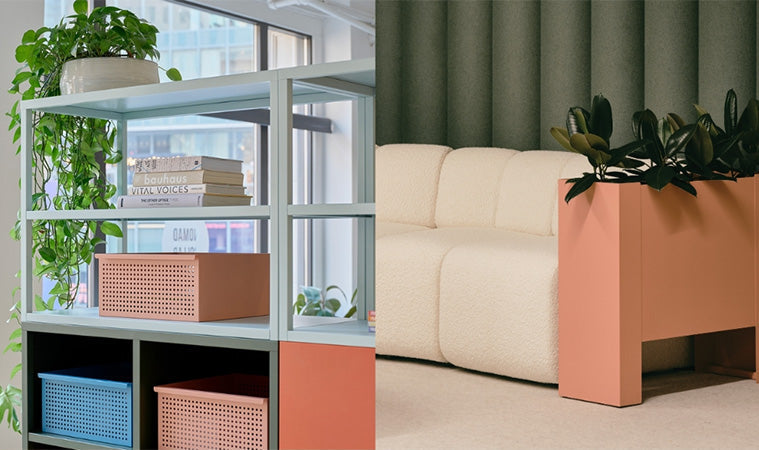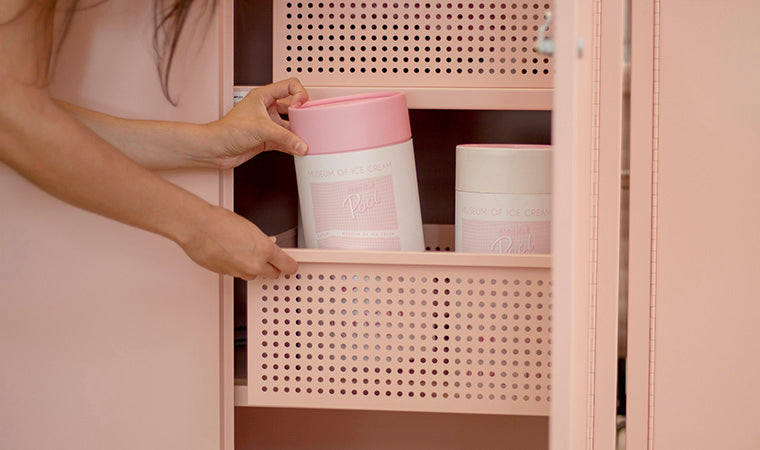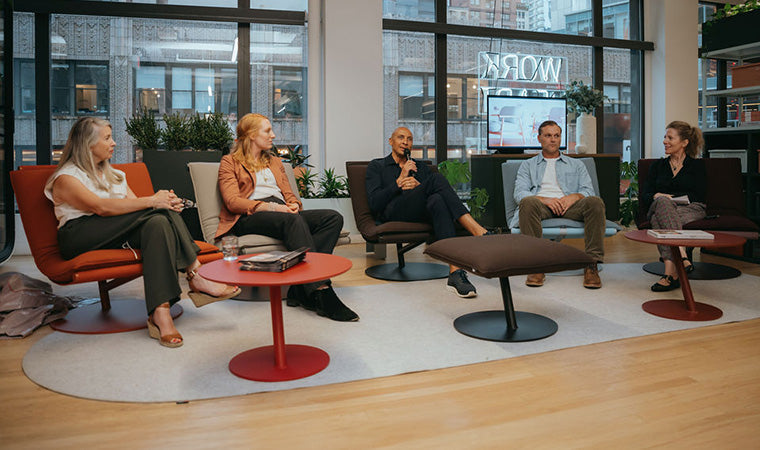We love working with designers whose work inspires us. Studio O+A is one such firm, and Design Director Mindi Weichman’s experience especially stood out to us. Her honest approach to working with clients who are questioning the practicality of the new hybrid workplace shows that designers already have all the tools they need to combat the difficulties surrounding the “return to work” question. It’s just a matter of being open-minded, steady, and self-assured, Mindi says.

Tell us about your most recent project, or the project you’re most proud of?
So, our most recent project is the one I’m most proud of, to be honest. We’ve been working nearly five years with Adidas at their North American head- quarters in Portland, Oregon. Recently, we completed two brand new, ground up buildings for them: the Gold Building and the Performance Zone, which is a gym. We’re also finishing up the Red Showroom for them this month. It’s always so great to see your project come to physical life.
Studio O+A has a strong philosophy of integrating a company’s brand into as many moments and aspects of a space as we can. So for Adidas that meant not only building in the idea of sport, but also articulating their strong stance on sustainability and innovation within the design. To this last point, both of the new buildings are LEED certified, and they were built with cross laminated timber (CLT). The gym was built entirely out of CLT, and the Gold Building features a mix of CLT and concrete. The Gold Building features offices, design labs, a cafeteria, a coffee bar, and a parking garage.

What are some challenges you face in designing workspaces today, especially with regards to the new hybrid work model?
I think the past two years have been filled with a lot of uncertainty — so much so that it’s made some clients extremely risk averse. Because we’re not fully out of the pandemic yet, there are these fluctuating attitudes around returning to the workplace and ambivalent feelings about what the workplace should be in the future. What components of the workplace should we keep, which should evolve, and which should die out? I think the best that designers can do for their clients right now is to remember to just stay nimble and keep looking forward. We have to encourage our clients to make decisions and feel comfortable with those decisions more than we ever did before.
Work spaces are going to look different from what they did a couple of years ago, and that’s okay. We live in a world where we now have to accept that one solution or approach isn’t going to fit everyone. I think if anything, this new era of workplace is really just going to force both designers and users to really think about what they need and how to best accommodate those necessities.
With regards to some of the new technologies that have become popular in the new hybrid workplace, I think some clients may still have aversion to or at least suspicion of them. Do they really work? Do they enable employees to be effective at their jobs? I think that the last couple of years have absolutely proven that they do work.
What do you think employees will need most from their new hybrid workplaces?
Studio O+A is based in the Bay Area, and we’ve seen definite regional differences in the return to work attitude. On the West Coast, some of the larger tech companies have no concrete plans to return to the office, ever. That attitude might slow down the evolution of the workplace over here. On the East Coast, companies have taken a much more active approach to figuring out when employees can safely return to the office, which I think is great. We’ve been encountering both attitudes and designing solutions for both types of clients since we work at a global scale.
I think the biggest thing for any workplace, regardless of location, will be flexibility, especially flexibility of space. People look forward to going back into an office because they miss socializing and collaborative moments. Designers facilitate those moments when we create and furnish spaces that prioritize those types of interactions.
What was something a client said to you recently that surprised you?
We were on the phone with a client a few weeks ago, laying out the frustrating reality of what’s going on in the industry right now — labor shortages, supply chain delays, burn out. Everyone is experiencing it. So, you can imagine my shock when the client said: “It’s fine. You can have more time [for the deliverable]. And yes, we will pay for your time.” It was a very human moment of understanding, a logical empathy.
If more clients were like that one, who was able to realize that design takes time, I think we could relieve a lot of the stress designers are feeling nowadays. I don’t know how likely it is for that to happen, but it was nice to at least have one client acknowledge that.
Where are you finding inspiration lately?
Well, right now I’m on my first trip in two years outside of the U.S. I used to do international travel almost every couple of months — for work and/or personal reasons — and not having that as an outlet for inspiration has been tough. I’ve been reminded of how nice it is just to be able to experience other architectures, people, food, etc.

I’ve also been finding a lot of inspiration in residential design. I think that it has really come to the forefront in the last few years with all of us turning our focus to our homes. I’ve been interested in how residential designers approach space-making. I want to learn how Studio O+A can learn from some of those thoughtful residential moments and apply that to the workplace.
In today’s hybrid work world, what does storage mean to you?
Well, I think something that storage will continue to do, but has always done well is support flexibility. Storage can mean really basic things, like office supplies, or the ability to flex an executive meeting room into a war room because you’ve got everything that you need for a quick transition carefully stored right there in the room. Even for a design firm, storage is indispensable for keeping all the things that you need right at your fingertips.
I think there are various levels of storage in the hybrid office that are going to become really important. I think having a really well thought out, well organized approach to storage is what will make hybrid workplaces really effective.
What comes to mind when you think of Heartwork?
Quality. Well built products. Clean and simple designs that can fit and flex into any type of environment.
Also, really good people. I’ve had the privilege to work with Heartwork on a couple of custom products for various clients, and I appreciate how Heartwork is so tuned into the details of a project. They take an interest in making sure that the products that they’re putting out there are a true reflection of themselves.
What is your favorite Heartwork color and why?
While I very much appreciate the variety of colors Heartwork offers, I love the white. It’s such a crisp, classic shade.
I’ve been helping my husband fit out his new studio space (he’s also an architect). We specified Heartwork’s lockers in Perfect White. They brought a clean sophistication to an office that otherwise was nothing special. The lockers also make really nice showcases for whatever is inside of them, too. And they complement the other materials used in the studio nicely.



